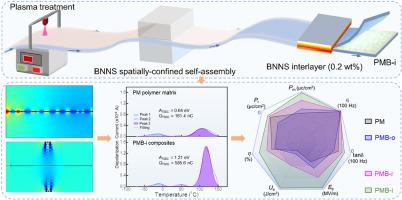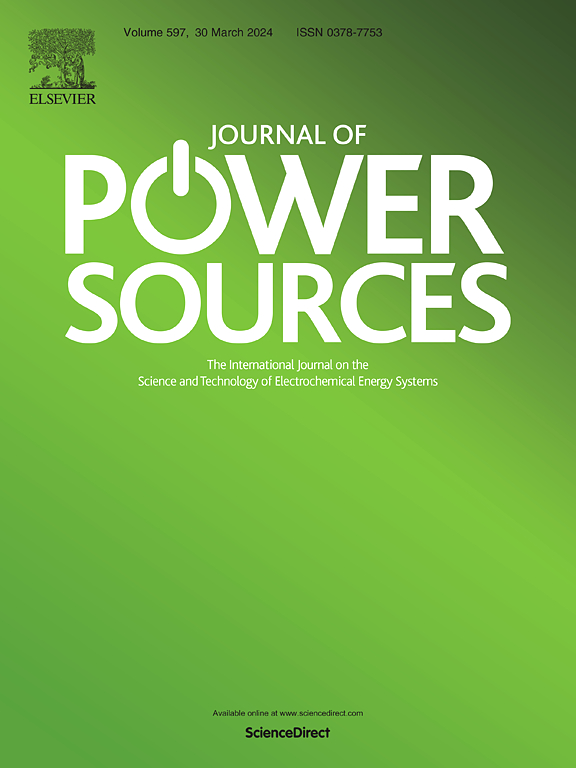聚合物纳米复合材料中的空间约束自组装氮化硼纳米片夹层显著提高了电容储能性能
IF 8.1
2区 工程技术
Q1 CHEMISTRY, PHYSICAL
引用次数: 0
摘要
高性能静电电容器是先进电子设备的迫切需要。传统的纳米电容器设计,如基于聚偏二氟乙烯(PVDF)和均匀分布的纳米填料的纳米复合材料,需要对填料界面进行费力的改性,且能量密度(Ue)和效率(η)有限。本文通过等离子体处理和氮化硼纳米片(BNNS)空间约束自组装技术,创新性地制备了氮化硼纳米片(BNNS)插层聚合物纳米复合材料。取向致密的互层 BNNS 大大抑制了漏电流,提高了纳米复合薄膜的击穿强度,优于随机或取向分布的 BNNS 系统,从而获得了 ∼24.1 J/cm3 的较高 Ue。此外,聚甲基丙烯酸甲酯和微量插层 BNNS 还能有效缓解 PVDF 的弛豫损耗,在 600 MV/m 时保持超高 η (76%),大大提高了储能性能。值得注意的是,这种新设计的纳米复合材料只需添加微量 BNNS(0.2 wt%),而无需进行填料表面改性。这些发现为高性能静电电容器的编程和制造提供了启示。本文章由计算机程序翻译,如有差异,请以英文原文为准。

Spatially-confined self-assembly boron nitride nanosheet interlayer in polymer nanocomposites significantly enhances the Capacitive energy storage performance
High-performance electrostatic capacitors are urgently needed of advanced electronic devices. Traditional nanodielectric designs, such as polyvinylidene fluoride (PVDF)-based nanocomposites with uniformly distributed nanofillers, necessitate laborious filler interface modification and yield limited energy density (Ue) and efficiency (η). Herein, boron nitride nanosheet (BNNS) intercalated polymer nanocomposites were innovatively prepared by plasma treatment and BNNS spatially-confined self-assembly techniques. The oriented dense interlayered BNNS substantially suppresses leakage current and bolsters the breakdown strength of nanocomposite films, outperforming randomly or oriented distributed BNNS systems, thus obtaining a higher Ue of ∼24.1 J/cm3. Moreover, the relaxation loss of PVDF could be effectively mitigated by polymethyl methacrylate and trace intercalated BNNS, maintaining an ultrahigh η (76 %) at 600 MV/m and greatly enhances the energy storage performance. Significantly, this newly designed nanocomposites necessitate only traces of BNNS (0.2 wt%) without filler-surface-modification. These findings afford insight into the programming and manufacture of high-performance electrostatic capacitors.
求助全文
通过发布文献求助,成功后即可免费获取论文全文。
去求助
来源期刊

Journal of Power Sources
工程技术-电化学
CiteScore
16.40
自引率
6.50%
发文量
1249
审稿时长
36 days
期刊介绍:
The Journal of Power Sources is a publication catering to researchers and technologists interested in various aspects of the science, technology, and applications of electrochemical power sources. It covers original research and reviews on primary and secondary batteries, fuel cells, supercapacitors, and photo-electrochemical cells.
Topics considered include the research, development and applications of nanomaterials and novel componentry for these devices. Examples of applications of these electrochemical power sources include:
• Portable electronics
• Electric and Hybrid Electric Vehicles
• Uninterruptible Power Supply (UPS) systems
• Storage of renewable energy
• Satellites and deep space probes
• Boats and ships, drones and aircrafts
• Wearable energy storage systems
 求助内容:
求助内容: 应助结果提醒方式:
应助结果提醒方式:


